16 UMMA Objects
16 UMMA Objects
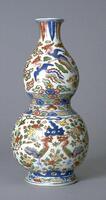
Chinese (Chinese (culture or style))
Double-Gourd Wall Vase
1573 – 1620
Gift of Marian Doering in memory of Paul M. Doering
1979/2.12
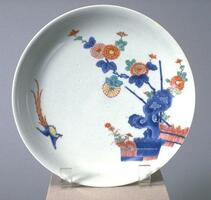
Japanese (Japanese (culture or style))
Arita ware dish with design of chrysanthemums by a brushwood fence
1700 – 1732
Gift of Mr. and Mrs. George F. Green
1970/2.1

Japanese (Japanese (culture or style))
Maru obi with woven designs of hexagonal medallions with phoenixes among floral scrolls
1933 – 1966
Gift of Howard and Patricia Yamaguchi
2005/1.345
![An ornament in the shape of a colorful bird, cut out of a single piece of wood and painted on both sides. A piece of bamboo has been nailed to the wing so that it could be inserted into a hole on the funeral bier. The bird has a blue face with green, white, red, orange, and yellow colorations over the body.<br />
<br />
This funeral bier ornament is made of a piece of wooden panel cut into the shape of a mythical bird called bonghwang and painted on both sides. A piece of bamboo has been nailed to its wing for insertion into a hole on the funeral bier. The species of the wood used is unknown.
<p>[Korean Collection, University of Michigan Museum of Art (2017), 218]</p>
An ornament in the shape of a colorful bird, cut out of a single piece of wood and painted on both sides. A piece of bamboo has been nailed to the wing so that it could be inserted into a hole on the funeral bier. The bird has a blue face with green, white, red, orange, and yellow colorations over the body.<br />
<br />
This funeral bier ornament is made of a piece of wooden panel cut into the shape of a mythical bird called bonghwang and painted on both sides. A piece of bamboo has been nailed to its wing for insertion into a hole on the funeral bier. The species of the wood used is unknown.
<p>[Korean Collection, University of Michigan Museum of Art (2017), 218]</p>](/media/W1siZiIsIjIwMjIvMDkvMjQvM3dvbjB4ZXJodF9kZWZhdWx0LmpwZyJdLFsicCIsInRodW1iIiwiMjQweDIwMCJdXQ?sha=774932ee5bd52d79)
Korean (Korean (culture or style))
Phoenix-shaped Ornament for Funeral Bier
1867 – 1932
Gift and partial purchase from Bruce and Inta Hasenkamp, purchase with funds from Elder and Mrs Sang-Yong Nam
2021/1.163
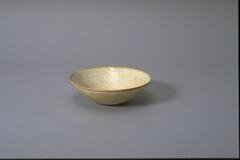
Chinese (Chinese (culture or style))
Bowl
960 – 1279
Gift of Mrs. Caroline I. Plumer for the James Marshall Plumer Collection
1973/2.18
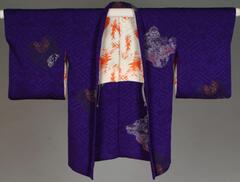
Japanese (Japanese (culture or style))
Purple haori with supplementary weft brocade woven bird-and-flowers designs
1930s
Gift of Howard and Patricia Yamaguchi
2005/1.355
![<p>This bowl is an example of an early celadon influenced by Chinese Yue ware. Similar vessels have been excavated from sedimentary layers of the Kiln no. 10 at Yongun-ri, Gangjin-gun, Jeollanam-do. The design, which features two parrots with their wings spread around the bowl’s inner wall, is also similar to the design found in Yue ware. This piece counts as medium quality ware, since its glaze is poorly fused. Refractory spurs are stuck around the rim, while the glaze has flowed downwards. There are six refractory spur marks on the shallow foot.<br />
[<em>Korean Collection, University of Michigan Museum of Art</em> (2014) p.90]</p>
Stoneware teabowl with celadon glaze. A pair of parrots is incised on he inside of the bowl, as well as a line that runs slightly below and parallel to the rim. <p>This bowl is an example of an early celadon influenced by Chinese Yue ware. Similar vessels have been excavated from sedimentary layers of the Kiln no. 10 at Yongun-ri, Gangjin-gun, Jeollanam-do. The design, which features two parrots with their wings spread around the bowl’s inner wall, is also similar to the design found in Yue ware. This piece counts as medium quality ware, since its glaze is poorly fused. Refractory spurs are stuck around the rim, while the glaze has flowed downwards. There are six refractory spur marks on the shallow foot.<br />
[<em>Korean Collection, University of Michigan Museum of Art</em> (2014) p.90]</p>
Stoneware teabowl with celadon glaze. A pair of parrots is incised on he inside of the bowl, as well as a line that runs slightly below and parallel to the rim.](/media/W1siZiIsIjIwMjIvMDkvMjQvMjU3MndxZ205aF9kZWZhdWx0LmpwZyJdLFsicCIsInRodW1iIiwiMjQweDIwMCJdXQ?sha=541f89daf7d4e36c)
Korean (Korean (culture or style))
Bowl with Double-Parrot Design
11th century
Gift of Bruce and Inta Hasenkamp and Museum purchase made possible by Elder and Mrs. Sang-Yong Nam
2004/1.213
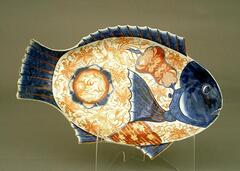
Japanese (Japanese (culture or style))
Imari fish plate with paintings of phoenix and hollyhock
1845 – 1855
Gift of the William T. and Dora G. Hunter Collection
2002/2.13
![This mirror features designs of two birds, coupled with floral motifs, positioned symmetrically on the left and right sides. Eight-foiled barbed bronze mirror is general. This type is a modified form of that.<br />
<br />
This blue-green bronze mirror decorated with a double crane design is excellently cast. It is five-lobed, and the registers are also divided by five-lobe shaped ridge. The outer register is decorated with scroll design while the inner register is adorned with a pair of cranes, with wings spread and heads turned right, arranged on either side of the central suspension loop against the honeysuckle scroll background. This object may be compared to other crane-patterned mirrors excavated from the Geumcheondong site tomb in Cheongju, Chungcheongbuk-do Province.
<p>[Korean Collection, University of Michigan Museum of Art (2017), 240]</p>
This mirror features designs of two birds, coupled with floral motifs, positioned symmetrically on the left and right sides. Eight-foiled barbed bronze mirror is general. This type is a modified form of that.<br />
<br />
This blue-green bronze mirror decorated with a double crane design is excellently cast. It is five-lobed, and the registers are also divided by five-lobe shaped ridge. The outer register is decorated with scroll design while the inner register is adorned with a pair of cranes, with wings spread and heads turned right, arranged on either side of the central suspension loop against the honeysuckle scroll background. This object may be compared to other crane-patterned mirrors excavated from the Geumcheondong site tomb in Cheongju, Chungcheongbuk-do Province.
<p>[Korean Collection, University of Michigan Museum of Art (2017), 240]</p>](/media/W1siZiIsIjIwMjIvMDkvMjQvMzEwd3h1ZjJqMl9kZWZhdWx0LmpwZyJdLFsicCIsInRodW1iIiwiMjQweDIwMCJdXQ?sha=ed2e566634b5d294)
Korean (Korean (culture or style))
Domed boss surrounded by raised band and dots, field of two phoenixes among flowers and vines, raised border with floral motif and five-lobed edges on both sides.
918 – 1392
Museum purchase made possible by the Margaret Watson Parker Art Collection Fund
1965/2.61
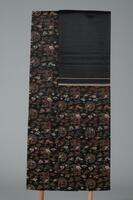
Japanese (Japanese (culture or style))
Obi
20th century
Gift of Howard and Patricia Yamaguchi
2013/2.380
Loading…
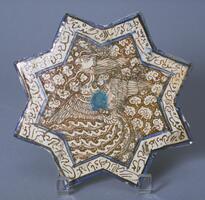
!["Object EFS-105 is a 14th century Mongolian-influenced Sultanabad work. The body of the object is a pinkish-tan while the outside is covered with painted blue tinge. The central motif is a spotted lion [leopard]. Stylized birds circle the inside of the object against a naturalistically conceived floral area. The object has been re-pieced extensively. <br /><br />
This object bears the characteristic hemispherical shape of Sultanabad work, and its rendering of the birds and floral motif indicate the Chinese influence of the 14th century. The animal and birds are outlined in black. It follows the general color scheme and motifs of the Sultanabad wares of the 14th century. <br /><br />
The object is 4 inches high and has a diameter of 8 inches. The lion [leopard] is rendered with the Iranian sensitivity and perceptiveness. This object was probably highlighted with white slip." "Object EFS-105 is a 14th century Mongolian-influenced Sultanabad work. The body of the object is a pinkish-tan while the outside is covered with painted blue tinge. The central motif is a spotted lion [leopard]. Stylized birds circle the inside of the object against a naturalistically conceived floral area. The object has been re-pieced extensively. <br /><br />
This object bears the characteristic hemispherical shape of Sultanabad work, and its rendering of the birds and floral motif indicate the Chinese influence of the 14th century. The animal and birds are outlined in black. It follows the general color scheme and motifs of the Sultanabad wares of the 14th century. <br /><br />
The object is 4 inches high and has a diameter of 8 inches. The lion [leopard] is rendered with the Iranian sensitivity and perceptiveness. This object was probably highlighted with white slip."](/media/W1siZiIsIjIwMjIvMDUvMjUvN3planB1NG5tbl9kZWZhdWx0LmpwZyJdLFsicCIsInRodW1iIiwiMjQweDIwMCJdXQ?sha=215dcc1d938a8d43)
